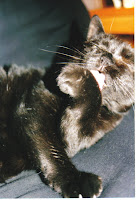 Gladys bathing in her younger days
Gladys bathing in her younger daysMy cat Gladys is moving very slowly these days. She is at least 18-years-old. She came to live with me the year before my daughter, Natalie, was born -- and Natalie is 16. Gladys was a young adult cat at the time of her rescue by a District of Columbia Animal Control Officer. She had been chased up a utility pole. According to witnesses, some kids sicked their pit bull on Gladys and she ran for her life. A couple of days after the chase she was still trying to figure out how to safely get down.
No one came to the shelter to claim her. Like so many animals in a city shelter, Gladys would have been euthanized (humanely killed with an injection of a drug sodium phenobarbital) -- simply put, there are way too many animals and not enough homes. Skinny little Gladys with the loud purr spoke to me. I decided to foster her. Gladys was spayed (operation so she can't have kittens and given all of her vaccinations) Obviously, my home became hers -- permanently. She's lived inside three houses with me over the last 17 years.
What if Gladys had not been rescued? What if she had been left on the streets? An un-spayed cat can have up to three litters of kittens a year. What happens to those kittens? Without human handling they become wild, or feral. A feral cat is a domestic cat who is abandoned and left to fend for itself -- eventaully, feral cats become fearful of all humans. Kittens born to feral mothers , essentially born in the wild, may never be socialized; feral cats lead very hard lives -- they must find food on their own; un-neutered, they get into many fights and are often injured; their illnesses and wounds go untreated; and their life expectancy is quite short compared to a well-cared-for, domestic house cat. Some times people will adopt a a colony (a large group) of feral cats. They will put out food for the cats at "feeding stations", trap them and have the cats spayed or neutered and then return them to the colony. Trap and release programs help to reduce the number of reproducing feral cats.
The Washington Animal Medical Center works with volunteer groups to reduce the feral cat population. We offer a feral cat spay/neuter clinic once a month. I've been at the League more than a year and so I've seen more than 12 feral cat spay/neuter days. Every time the volunteers bring in 25-50 feral cats. Since feral cats are weary of humans, the volunteers catch the cats in humane traps and bring them to the Medical Center in the traps. The veterinarians spay or neuter each cat, check them for diseases like feline leukemia, vaccinate them, and notch their ears -- the notched ear identifies the cats as those being looked after in the colony.
Washington Animal Medical Center works with volunteer groups to reduce the feral cat population. We offer a feral cat spay/neuter clinic once a month. I've been at the League more than a year and so I've seen more than 12 feral cat spay/neuter days. Every time the volunteers bring in 25-50 feral cats. Since feral cats are weary of humans, the volunteers catch the cats in humane traps and bring them to the Medical Center in the traps. The veterinarians spay or neuter each cat, check them for diseases like feline leukemia, vaccinate them, and notch their ears -- the notched ear identifies the cats as those being looked after in the colony.
 Washington Animal Medical Center works with volunteer groups to reduce the feral cat population. We offer a feral cat spay/neuter clinic once a month. I've been at the League more than a year and so I've seen more than 12 feral cat spay/neuter days. Every time the volunteers bring in 25-50 feral cats. Since feral cats are weary of humans, the volunteers catch the cats in humane traps and bring them to the Medical Center in the traps. The veterinarians spay or neuter each cat, check them for diseases like feline leukemia, vaccinate them, and notch their ears -- the notched ear identifies the cats as those being looked after in the colony.
Washington Animal Medical Center works with volunteer groups to reduce the feral cat population. We offer a feral cat spay/neuter clinic once a month. I've been at the League more than a year and so I've seen more than 12 feral cat spay/neuter days. Every time the volunteers bring in 25-50 feral cats. Since feral cats are weary of humans, the volunteers catch the cats in humane traps and bring them to the Medical Center in the traps. The veterinarians spay or neuter each cat, check them for diseases like feline leukemia, vaccinate them, and notch their ears -- the notched ear identifies the cats as those being looked after in the colony. Old, creaky-bones Gladys spends her days sleeping on a chair or sunning in the window. She could have been killed by that dog more than 17-years ago, or she could have escaped and been left to fend for herself giving birth to litter after litter of unwanted kittens.
Feral cats are a problem. I'm glad that the League's Medical Center is helping to control the feral cat crisis. But, there is still so much more to be done. What do you think should be done to reduce the number of feral cats who are left on own to survive?


No comments:
Post a Comment